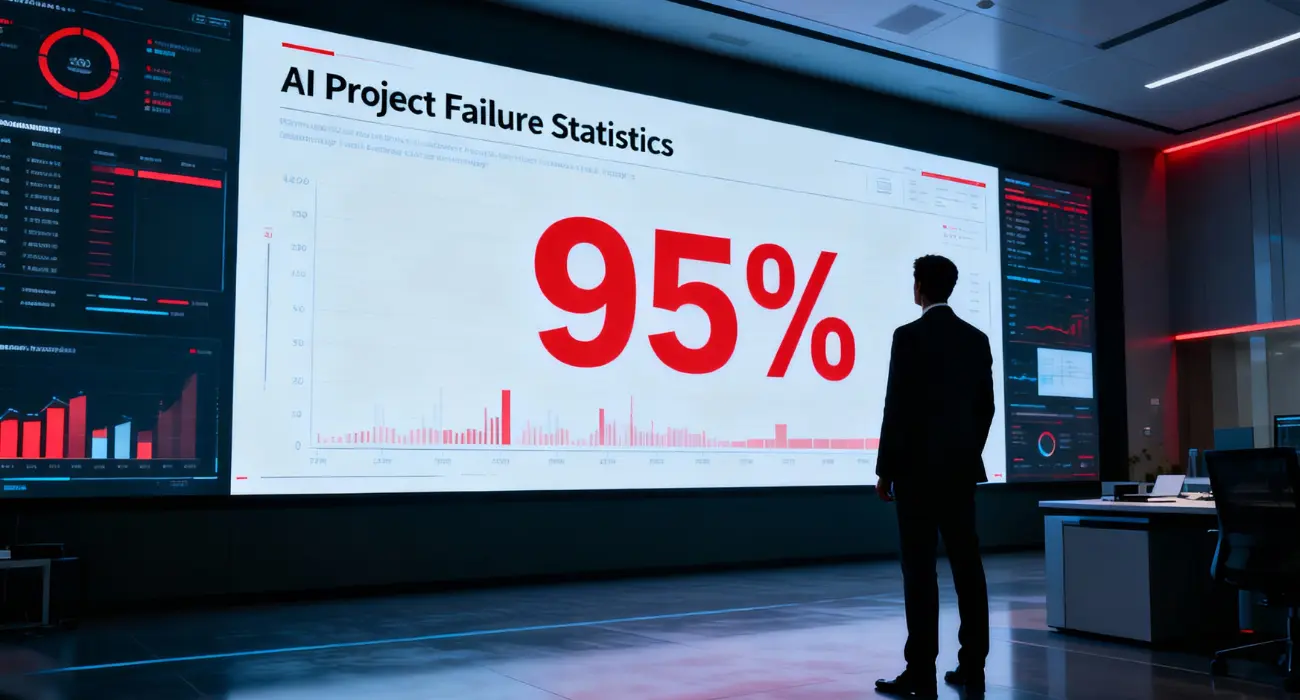A groundbreaking study from MIT’s Project NANDA has sent shockwaves through the business and technology sectors, revealing that 95% of generative AI pilot projects fail to deliver measurable financial returns. The report, titled “The GenAI Divide: State of AI in Business 2025,” represents one of the most comprehensive analyses to date of AI implementation in enterprise settings.
The Study: Methodology and Scope
The research, led by Aditya Challapally and his team at MIT’s NANDA (Networked Agents And Decentralized Architecture) initiative, is based on rigorous methodology that includes:
- 150 in-depth interviews with business leaders and executives
- Survey of 350+ employees across various industries
- Analysis of 300+ public AI deployments from January to June 2025
- 52 structured organizational interviews for detailed case studies
The findings paint a stark picture: despite $30-40 billion invested in generative AI initiatives during 2025, only 5% of pilot programs achieve rapid revenue acceleration, while the vast majority deliver little to no measurable impact on profit and loss statements.
The Core Problem: Not Technology, But Integration
In an interview with Fortune, Challapally emphasized a critical insight: “The problem isn’t the quality of the AI models, but the learning gap for both tools and organizations.” While executives often point to regulation or model performance as culprits, MIT’s research reveals the real issue lies in flawed enterprise integration.
See also AI in Food & Beverages Market to Surge from $11.08B to $263.80B by 2032
AI in Food & Beverages Market to Surge from $11.08B to $263.80B by 2032Generic AI tools like ChatGPT excel for individual users due to their flexibility, but they struggle in enterprise environments because they don’t learn from or adapt to existing workflows. This fundamental disconnect has been termed the “GenAI Divide” by researchers.
Key Barriers to Success:
- Lack of contextual learning: AI systems don’t retain feedback or improve over time without proper integration
- Workflow incompatibility: Tools fail to adapt to established enterprise processes
- Insufficient organizational change: Companies implement AI as a “technological patch” without restructuring processes
- Misaligned deployment strategies: Resources allocated to high-visibility areas rather than high-ROI functions
Vendor Solutions vs. Internal Development: A Clear Winner
One of the study’s most significant findings reveals a dramatic difference in success rates based on implementation strategy. AI tools purchased from specialized vendors succeed approximately 67% of the time, while internally developed systems succeed only about 33% of the time—a two-to-one ratio.
This finding has particular implications for financial services and other highly regulated sectors, where many firms are currently building proprietary generative AI systems. “Almost everywhere we went, enterprises were trying to build their own tool,” Challapally noted, “but the data showed purchased solutions delivered more reliable results.”
Investment Misallocation: Following Hype Over ROI
The research reveals a troubling disconnect between where companies invest AI budgets and where actual returns materialize. More than half of generative AI budgets flow to sales and marketing tools, yet MIT found the biggest ROI comes from back-office automation—eliminating business process outsourcing, cutting external agency costs, and streamlining operations.
As an unidentified COO at a mid-market manufacturing firm told researchers: “The hype on LinkedIn says everything has changed, but in our operations, nothing fundamental has shifted. We’re processing some contracts faster, but that’s all that has changed.”
The Shadow AI Economy: Employees Leading the Way
The study uncovered an intriguing parallel phenomenon: while official enterprise AI initiatives stall, a robust “shadow AI economy” is flourishing. Despite only 40% of companies purchasing official LLM subscriptions, employees in over 90% of companies regularly use personal AI tools for work—often with better ROI than formal initiatives.
Many employees describe using tools like ChatGPT and Claude multiple times daily, with adoption far outpacing their companies’ sanctioned AI programs stuck in pilot stages. This grassroots adoption reveals what actually works while highlighting the failure of top-down implementation strategies.
Sector-Specific Impact: Technology and Media Lead
The NANDA report indicates that generative AI is having material impact in only two out of nine industrial sectors analyzed: Technology and Media & Telecommunications. For the remaining sectors—Professional Services, Healthcare & Pharma, Consumer & Retail, Financial Services, Advanced Industries, and Energy & Materials—generative AI has been largely inconsequential to date.
In Technology and Media sectors, more than 80% of executives anticipate reduced hiring volumes within 24 months, indicating significant structural changes underway.
Workforce Transformation: Quiet Attrition Over Mass Layoffs
Contrary to widespread fears of AI-driven mass unemployment, the study found no evidence of widespread layoffs directly tied to generative AI. Instead, companies are pursuing a “soft attrition” strategy—choosing not to replace positions in administrative and customer support areas as they become vacant.
This gradual workforce reshaping is particularly pronounced in roles that were previously outsourced, making AI’s entry a replacement for offshore contractors rather than core employees.
What Successful Companies Do Differently
The 5% of companies achieving success with AI share distinct characteristics that separate them from the struggling majority:
Strategic Approaches of Top Performers:
- Focus on specific pain points: Rather than broad implementations, successful companies identify and execute on narrow, high-value use cases
- Partner strategically: They collaborate with specialized vendors who understand their specific industry and workflows
- Empower line managers: Success comes from distributing AI adoption across the organization, not confining it to central AI labs
- Demand deep customization: Top performers treat AI procurement as business process outsourcing rather than software-as-a-service
- Select adaptive tools: They choose solutions that can integrate deeply and evolve over time
- Establish clear metrics: Successful implementations include measurable KPIs and ROI tracking from the outset
Challapally highlighted young startups as exemplars of this focused approach: “Startups led by 19- or 20-year-olds have seen revenues jump from zero to $20 million in a year. It’s because they pick one pain point, execute well, and partner smartly with companies who use their tools.”
Recommendations for Closing the GenAI Divide
Based on their extensive research, the MIT team offers clear guidance for organizations seeking to avoid the 95% failure rate:
Critical Success Factors:
- Prioritize verifiable ROI: Focus on use cases with clear, measurable business impact rather than implementing AI everywhere
- Invest in organizational capacity: Develop talent, governance structures, and change management capabilities alongside technology
- Start with back-office automation: Target high-ROI areas like operations, finance, and compliance before customer-facing applications
- Deploy comprehensive scale tests: Include all affected areas and stakeholders in pilot programs
- Consider vendor partnerships: Given the 2:1 success ratio, carefully evaluate build vs. buy decisions
- Enable workflow integration: Choose tools that adapt to existing processes rather than forcing process changes
- Distribute AI literacy: Build understanding across all organizational levels, not just technical teams
Market Implications and Future Outlook
The study’s release in August 2025 contributed to significant market volatility, with shares of AI-focused companies like Nvidia, Microsoft, and Alphabet experiencing sharp declines as investors reassessed the timeline for AI returns. Analysts warn of potential risks of overvaluation and market correction if tangible returns don’t materialize soon.
However, the report emphasizes that the issue isn’t with AI technology itself, but with implementation strategies. The 5% success rate proves that transformative results are achievable—just not with the approaches most companies are currently taking.
Criticism and Limitations
Some industry observers have noted limitations in the study’s methodology. The analysis is based on approximately 300 publicly disclosed AI deployments and 52 organizational interviews—a significant but not comprehensive sample. Additionally, some argue that many AI pilots are still in early stages and may require longer observation periods before meaningful results emerge.
The study’s narrow definition of success—”deployment beyond pilot phase with measurable KPIs” and “ROI impact measured six months post-pilot”—has been criticized for potentially ignoring other valuable impacts such as efficiency gains, employee satisfaction, or competitive positioning that may not immediately show on P&L statements.
The Path Forward
As Challapally concluded: “Companies that adapt their workflows and decision-making structures to AI will pull ahead. Those that don’t risk being stuck in endless pilots that never deliver.”
The current situation represents both a crisis and an opportunity. Organizations have an 18-month window as enterprise contracts lock in to either join the successful 5% or risk becoming part of a growing wave of AI disillusionment. The decisions made now will determine whether generative AI fulfills its transformative promise or becomes another overhyped technology that failed to deliver on enterprise expectations.
For business leaders, the message is clear: success with AI requires not just adopting new technology, but fundamentally rethinking how organizations operate, learn, and adapt.
Study References:
- Report Title: “The GenAI Divide: State of AI in Business 2025”
- Authors: Aditya Challapally, Chris Pease, Ramesh Raskar, Pradyumna Chari
- Organization: MIT NANDA (Networked Agents And Decentralized Architecture)
- Publication Date: July 2025
- Coverage: Fortune, Axios, The Register
Contents
- 1 The Study: Methodology and Scope
- 2 The Core Problem: Not Technology, But Integration
- 3 Vendor Solutions vs. Internal Development: A Clear Winner
- 4 Investment Misallocation: Following Hype Over ROI
- 5 The Shadow AI Economy: Employees Leading the Way
- 6 Sector-Specific Impact: Technology and Media Lead
- 7 Workforce Transformation: Quiet Attrition Over Mass Layoffs
- 8 What Successful Companies Do Differently
- 9 Recommendations for Closing the GenAI Divide
- 10 Market Implications and Future Outlook
- 11 Criticism and Limitations
- 12 The Path Forward








































































